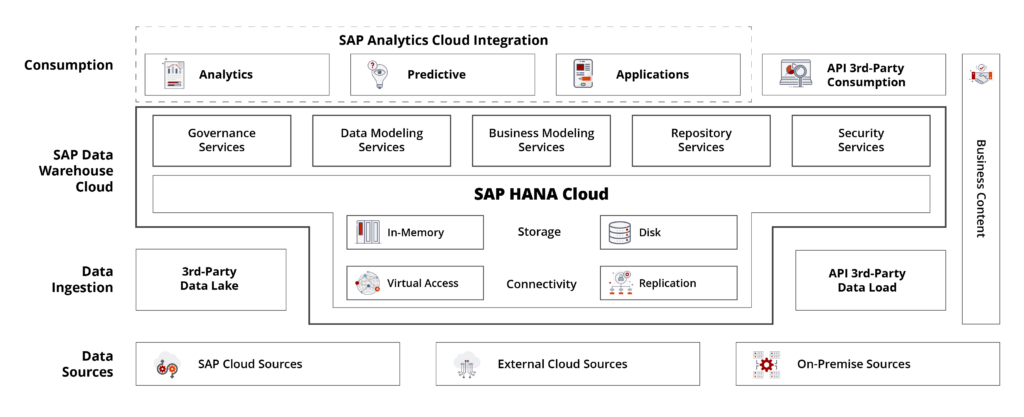Have you ever thought about how data influences our world?
Imagine a scenario where intricate data fragments converge, leading to collective insights that unearth new perspectives.
Now, step into the captivating realm of SAP Datasphere (formerly SAP Data Warehouse Cloud), a technological masterpiece that transcends the ordinary boundaries of data management.
Are you ready to embark on a voyage of enlightenment?
Join us on this exhilarating expedition as we delve deep into the SAP Data Warehouse Cloud architecture (SAP DWC). Also uncover the very heart of its core components and explore the pivotal features that have catapulted this platform to the forefront of modern data management.
Get ready for a journey that unveils the power of SAP DWC—a force that is reshaping the landscape of data utilization.
Introduction to SAP Data Warehouse Cloud
In a world characterized by data deluge, SAP DWC emerges as the lighthouse guiding organizations through the sea of information. It’s more than just a repository; it’s a dynamic hub that thrives on data transformation and exploration. Here’s a glimpse into what makes this solution stand out:
Data Transformation at its Core: SAP DWC is not just a storage solution; it’s a platform that transforms raw data into actionable insights. By harmonizing data from various sources, it empowers organizations to extract meaningful patterns and trends that drive business decisions.
SAP Data Warehouse Cloud Architecture: Overview
At the heart of this solution prowess lies its architecture, which seamlessly integrates various services to offer an all-encompassing data management solution.
- Data Modeling Services:
Empowers users to design logical and physical data models, ensuring optimal data organization for efficient storage and retrieval.
- Governance Services:
The architecture enforces data quality standards, compliance, and permissions, ensuring the reliability of data for informed decisions.
- Business Modeling:
Users can define KPIs, metrics, and calculations to extract valuable insights, aligning data with business processes.
- Repository Services:
SAP DWC’s central repository facilitates version control, collaboration, and sharing of data artifacts among teams, promoting consistency.
- Security Services:
Robust security measures, including authentication, authorization, and encryption, safeguard data against unauthorized access and breaches.
- Integration Services:
SAP DWC’s capability to integrate on-premises, cloud, and third-party data sources offers a holistic view of an organization’s data landscape.
Data Ingestion: The Gateway to Intelligent Decision-Making
Data ingestion is the foundation of effective data management, and ensures a seamless process.
- SAP Analytics Cloud Ingestion:
SAP DWC’s integration with SAP Analytics Cloud allows real-time data access, empowering dynamic dashboard creation based on the latest data.
- Third-Party Data Lakes:
By seamlessly connecting with third-party data lakes, this solution accommodates the integration of existing data sources, be they on-premises or cloud-based.
- API-Based Data Loading:
Organizations can leverage APIs to directly pull data from external systems, enhancing data integration agility.
Diverse Data Sources Supported:
- SAP Cloud Sources:
Involves integration with various SAP cloud solutions for data extraction from platforms like SAP S/4HANA and SuccessFactors.
- External Cloud Sources:
Extends to external cloud applications, databases, and storage solutions, harmonizing data for comprehensive insights.
- On-Premise Cloud Sources:
Securely connects and integrates on-premises data into the cloud environment.
Core Components Powering SAP DWC
SAP DWC’s architecture is a symphony of interconnected components that work in harmony to streamline data management and analysis. Let’s delve into the essence of these components:
-
Data Integration: Bringing Data Together
Think of data integration as the glue that binds different pieces of data together. It’s like a puzzle coming together, where different connectors make sure data flows effortlessly. This means no more isolated chunks of data – everything comes together for a more complete picture.
-
Data Modeling: Shaping Data for Easy Understanding
Data can be complex, like a maze. But with SAP Data Warehouse Cloud, it’s as simple as a paint-by-numbers kit. The user-friendly interface lets even non-tech folks create and modify data models. It’s like making a recipe – you put in the right ingredients to create something delicious. This lets businesses mold data to fit their needs and make better decisions.
-
Data Storage: Your Cloud-based Library
Imagine a magical cloud library where you can store and retrieve data without worrying about physical shelves. That’s what SAP DWC offers with cloud-based storage. It’s like having all your books in one place, ready for you to pick up whenever you want. No more hunting for information – it’s all there, waiting for you.
Unraveling the Key Features of SAP DWC
Here are some key features that make it a standout platform in the world of data management and analytics
- Unified Data Management:
Offers a single platform for integrating, modeling, and analyzing data from diverse sources. This approach eliminates data silos and provides a comprehensive view of information.
- Collaborative Workspace:
Real-time collaboration capabilities enable teams to work together on data models and analysis. This fosters cross-functional teamwork and ensures data consistency throughout the organization.
- Data Virtualization:
The platform’s data virtualization feature abstracts the physical location of data. This allows users to access and analyze information seamlessly without needing to know where it resides.
- Advanced Analytics:
With advanced analytics tools, including predictive capabilities, users can uncover actionable insights and trends within their data. This empowers data analysts and scientists to drive informed decision-making.
- Integrated Business Intelligence:
Seamlessly integrating with analytics tools, it enables the creation of interactive dashboards, visualizations, and reports. This enhances the communication of data-driven insights.
- Security and Compliance:
Emphasizing data security, the platform offers robust measures such as encryption and access controls. These features protect data integrity and ensure compliance with regulations.
- Scalability and Performance:
Built on a cloud-native architecture, it scales effortlessly as data volumes grow. Performance optimization techniques guarantee fast query responses and efficient data processing.
By unifying data management, fostering collaboration, abstracting data location, and offering advanced analytics, integrated BI, security, and scalability, this solution equips businesses with the tools they need to thrive in a data-driven world.
Final Thought:
As businesses navigate the shifting data landscape, SAP Data Warehouse Cloud takes the spotlight, gaining recognition from existing data warehousing customers. To cater to their need for a seamless transition without reinventing the wheel, the SAP BW bridge steps in. This strategic solution not only expedites the move to cloud data warehousing but also safeguards past investments. By seamlessly integrating on-premises SAP Business Suite data, it paves the way for rapid innovation within a unified, open, cloud-based data and analytics environment.
To begin your journey with SAP Data Warehouse Cloud, explore further resources: delve into the Best Practices available within the Community for SAP Data Warehouse Cloud. Don’t miss the insightful blog post addressing this topic. Additionally, gain an overview of SAP Data Warehouse Cloud and SAP BW bridge from the provided brochure.
Got questions? Feel free to reach out to KaarTech!!
FAQ’s
What is SAP Data Warehouse Cloud?
SAP Data Warehouse Cloud isn’t just storage; it’s a dynamic platform transforming raw data into actionable insights. It harmonizes data from diverse sources, empowering organizations to extract meaningful patterns for informed decisions.
What are the Core Components of this solution?
The key components include data integration, modeling, and storage. Data integration blends information from various sources seamlessly, while modeling simplifies data structuring. Storage ensures secure cloud-based access to data.
What are the Standout Features of this solution?
Notable features include unified data management, collaborative workspace, data virtualization, advanced analytics, integrated BI, robust security, and scalable performance. These facets enable comprehensive data-driven decision-making.
How does SAP DWC Transition from SAP BW?
The SAP BW bridge facilitates a seamless transition to cloud data warehousing. It integrates on-premises SAP Business Suite data, ensuring a smooth move while preserving past investments and enabling rapid innovation in a unified cloud-based analytics environment.
One Comment
Comments are closed.


Excellent blog here! Also your website loads up very fast! What web host are you using? Can I get your affiliate link to your host? I wish my web site loaded up as quickly as yours lol